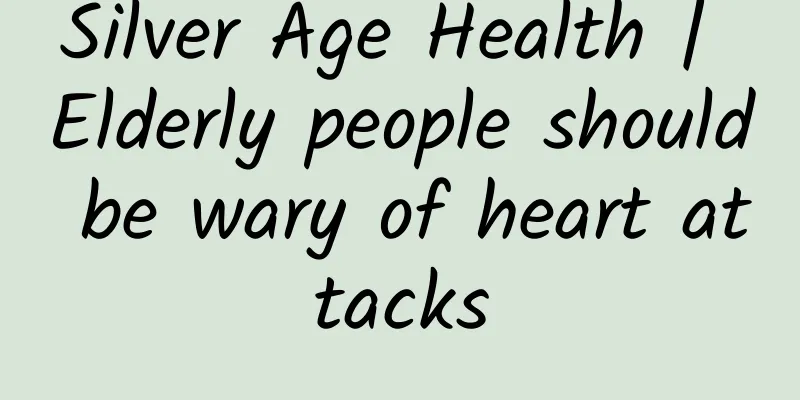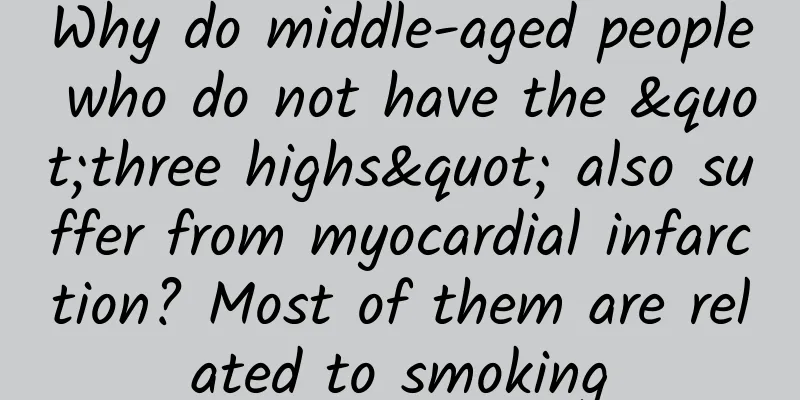|
The physical changes in the elderly are subtle and complex, among which cardiovascular diseases are particularly noteworthy. Myocardial infarction (MI), as an acute and critical cardiovascular disease, often occurs unexpectedly. In fact, MI is not without signs. Understanding and identifying the signs of MI in the elderly is crucial for early intervention and saving lives. ▏Warning before myocardial infarction First Alarm: A silent wake-up call.
When the rhythm of life deviates from the healthy track, we quietly approach coronary atherosclerosis and coronary heart disease. Although this initial alarm is not ostentatious, it quietly conveys important information: long-term bad habits such as smoking, drinking, sitting for a long time, obesity, unhealthy diet, staying up late and being under great pressure are silently threatening our cardiovascular health. The accumulation of these bad habits means that the risk of coronary heart disease is gradually increasing. Therefore, we must be vigilant and abandon these unhealthy lifestyles as soon as possible. Especially for those with family history, high-risk factors and three high conditions, healthy living habits should be regarded as amulets. These people should regularly check their blood pressure, blood sugar and blood lipid levels. If abnormalities are found, they must actively and formally receive treatment and long-term monitoring to maintain health. Although the first alarm is mild, if ignored, cardiovascular problems may gradually worsen and even develop into coronary heart disease or myocardial infarction.
Second alert: The three highs are not under control.
Although many people know that they suffer from high blood pressure, diabetes or high blood lipids, they do not pay enough attention to it. Leaving the three highs unchecked will accelerate the accumulation of blood vessel garbage, leading to cardiovascular stenosis and eventually causing coronary heart disease. If coronary heart disease has been diagnosed but the regular treatment plan is not followed, or even health supplements are chosen instead of drug treatment, this will worsen the coronary heart disease and even form blood clots, eventually leading to myocardial infarction. Therefore, we must actively monitor blood pressure, blood sugar, and blood lipid levels. Failure to control the three highs is an early warning sign of myocardial infarction, and failure to receive regular treatment for coronary heart disease is another warning of myocardial infarction.
Third Alert: Recurrent attacks of angina pectoris.
The most typical symptom of myocardial infarction is angina pectoris, and each attack may be the last warning of myocardial infarction. Unfortunately, however, many patients ignore or misunderstand these warning signs. For example, a patient felt heart discomfort many times but mistakenly thought it was back pain and failed to seek medical treatment in time. Angina pectoris is not limited to pain in the precordial area. Some signs of myocardial infarction are unexpected but can be fatal. Therefore, we must remain highly vigilant against repeated attacks of angina pectoris and seek medical treatment in time to avoid missing the last chance to seek help. ▏Some unexpected signs of heart attack Some symptoms of a heart attack are completely unexpected and must be kept in mind by everyone. 1. Sudden deafness in both ears A middle-aged man who had been working hard and socializing for a long time suddenly felt a buzzing in both ears and lost his hearing. After diagnosis by a professional ENT hospital, it was diagnosed as a lesion in the right ear. After the operation, the right ear had no hearing at all, but the left ear still had weak hearing. However, during the physical examination at the company, it was found that his coronary artery was blocked. After treatment, surprisingly, his left ear hearing was miraculously restored, as if he was reborn. This change effectively alleviated the patient's angina pectoris and hearing problems.
2. Umbilical pain Umbilical pain is often mistaken for gastrointestinal problems, but for people at high risk of myocardial infarction, it may be a precursor to myocardial infarction. One morning in early winter, Lao Gao began to feel stomach pain after going out for a walk. At first he thought it was a stomachache, but the pain became more and more intense and abnormally located around the navel. After considering his age and weather factors, the doctor highly suspected angina pectoris. After an electrocardiogram, it was confirmed to be acute inferior wall myocardial infarction. After a thrombus aspiration operation, Lao Gao's periumbilical pain disappeared immediately.
3. Pain in the soles of the feet Although pain in the soles of the feet is not a typical symptom of myocardial infarction, it should also be paid attention to. An elderly man in Shandong underwent stent surgery for acute myocardial infarction. After the surgery, the doctor asked him if he had any previous symptoms that had now disappeared. The old man recalled that when he walked before, the soles of his feet always felt like being pricked by needles and he could not walk far. Now this pain has disappeared. Although this symptom is not common, it is not an isolated case, and some patients do experience similar situations.
4. Unable to open eyes A middle-aged male patient in Shijiazhuang has been unable to open his eyes for eight years. After examination and evaluation, it was found that he was a patient with heart failure. Further angiography showed that the anterior descending branch of his heart was blocked by 99%. After emergency surgery to open the blood vessels, surprisingly, the patient's eyes were able to open. Although the relationship between cardiac ischemia and eyes cannot be determined at present, doctors remind that if the eyes suddenly become unclear or unable to open, heart problems should also be considered.
5. Left leg numbness and soreness Left leg numbness and soreness is also a warning sign for people at high risk of myocardial infarction. A female patient from Shandong felt soreness and soreness in her left leg a few months before the operation. She tried acupuncture and cupping but to no avail. After the physical examination, she found that her cardiovascular system was blocked and underwent surgery. After the operation, her leg pain disappeared.
6. Chest restraint Feeling like being wrapped in tape or having a restrained feeling in the chest may be a sign of myocardial infarction. A real estate owner always felt that his chest was restrained as if it was wrapped in transparent tape. After examination, it was confirmed that he had myocardial ischemia. After further examination of the cardiovascular system, it was found that it was a blockage in the cardiovascular system. After treatment, his strange symptoms disappeared.
7. Toothache Toothache is another atypical symptom of myocardial infarction. Dr. Zhang Jian reminds that for high-risk groups, the possibility of myocardial ischemia should be ruled out first when toothache occurs. A patient in Changchun often suffered from toothache in the left lower jaw, but no problem was found after multiple dental examinations. Later, it was diagnosed as myocardial ischemia, and after surgery to open the blood vessels, the toothache disappeared.
8. Dizziness Although dizziness is one of the symptoms of many diseases, it can also be a sign of myocardial infarction. A patient from Inner Mongolia suffered from dizziness for many years. After various examinations including intracranial angiography, CT, and MRI, no problems were found. Later, he underwent coronary intervention. Unexpectedly, the dizziness symptoms were relieved and disappeared soon after the operation.
9. Shoulder blade pain Shoulder blade pain may also be a sign of myocardial infarction. A female patient always felt a slight pain in her shoulder blade, as if there was air leaking. She initially thought it was rheumatoid arthritis, but after examination, it was found to be a cardiovascular problem. After treatment, her shoulder blade pain also disappeared. Therefore, for high-risk groups, the situation accompanied by shoulder blade pain should be vigilant.
10. Weakness of the left upper limb Weakness of the left upper limb is another manifestation of myocardial ischemia. Mr. Sun from Beijing always felt weakness in his left upper limb accompanied by soreness, numbness, swelling and pain. After examination, it was basically determined that his symptoms were manifestations of myocardial ischemia. After the stent was placed in the narrow part, his symptoms of weakness in the left upper limb disappeared immediately. This situation is not an isolated case. Many patients will experience symptoms such as discomfort, soreness, swelling, and weakness in the left shoulder blade and left upper limb. After examination, it was found that it was myocardial ischemia. After improvement through medication or surgical treatment, the symptoms will disappear quickly.
11. Sudden fatigue and unwillingness to move For the elderly, sudden laziness and fatigue may be an early sign of myocardial ischemia. Elderly people who do not have other obvious symptoms of myocardial infarction and discomfort may feel fatigue, drowsiness, unwillingness to move, etc. When abnormal conditions occur, they should be highly alert to myocardial ischemia and seek medical attention in time to avoid delaying treatment.
12. Headache Headache is also an atypical but noteworthy sign of myocardial infarction. An elderly female patient had a headache at the back of her head and it got worse when she was walking. After multiple examinations and treatments for headaches and blood pressure, no problems were found. Later, a cardiovascular examination revealed severe stenosis and calcification of the right coronary artery. After treatment, the headache symptoms disappeared and she no longer had a headache when she walked far or fast. Therefore, for high-risk groups, headaches should also be considered as a sign of myocardial infarction and require further examination and diagnosis.
By remembering these early signs of myocardial infarction, we can identify and take measures before the crisis strikes to avoid possible loss of life and property in the future. Once signs of myocardial infarction appear, please call 120 for emergency treatment immediately. When facing such a disease, time is life. ▏Nitroglycerin and quick-acting heart-saving pills First, let's learn about two drugs: nitroglycerin and quick-acting heart-saving pills. Both drugs are for the same disease - angina pectoris. Angina pectoris is a typical symptom of coronary heart disease, mainly due to high blood lipids, plaque formation, narrowing of heart vessels, and insufficient blood supply to the myocardium. When patients are tired or emotionally excited, they may experience symptoms of angina pectoris. The main function of these two drugs is to dilate blood vessels, temporarily unblock blocked blood vessels, and thus relieve chest pain symptoms.
1. Guidelines for the use of nitroglycerin Nitroglycerin is the first-choice emergency medicine for patients with coronary heart disease. For patients who have been diagnosed with coronary heart disease, nitroglycerin should always be available. When acute angina pectoris occurs, that is, chest pain after exertion or chest tightness, patients can take nitroglycerin sublingually. When using nitroglycerin, pay attention to the following points:
1. Correct use: Place the tablet under the tongue and hold it in your mouth. Do not swallow it. You can chew it slightly. It will take effect 2-3 minutes after holding it in your mouth and the effect can last for 20-30 minutes. It is recommended to hold it in your mouth while sitting to avoid insufficient blood supply to the brain due to low blood pressure.
2. Precautions for special groups: Patients who often suffer from low blood pressure, glaucoma, cerebral hemorrhage or high intracranial pressure should consult a doctor or pharmacist before use.
3. Storage method: The tablets should be placed in a brown glass bottle, away from light and stored at room temperature (no more than 30°C). Do not put them in your pocket when you go out, so as not to affect the efficacy due to high body temperature. The shelf life of nitroglycerin is usually one year. Even if it is not used up, it is best to replace it regularly.
2. Emergency effects of Suxiao Jiuxin Pills Suxiao Jiuxin Pills are a Chinese patent medicine that has the effects of promoting qi and blood circulation and dilating blood vessels. Although it is not as fast as nitroglycerin, it is also an effective emergency medicine in emergency situations. For people at high risk of coronary heart disease, such as the elderly, patients with three highs, long-term smokers, and obese people, they can always have Suxiao Jiuxin Pills.
1. Timing of use: When high-risk people have symptoms of angina pectoris, such as chest tightness, discomfort in the precordial area, and soreness in the left shoulder, they can take Suxiao Jiuxin Pills sublingually. For patients with confirmed coronary heart disease, when angina pectoris occurs, Suxiao Jiuxin Pills can also be used in the following situations: when there is no nitroglycerin, the patient has contraindications to taking nitroglycerin, or the patient cannot tolerate the adverse reactions of nitroglycerin.
2. Correct use: When acute angina pectoris attacks, take 10-15 Suxiao Jiuxin Pills sublingually at one time. If it is ineffective, take it again after 10 minutes. Although the antihypertensive effect of Suxiao Jiuxin Pills is weaker than that of nitroglycerin, it is also recommended to take it while sitting. In addition, Suxiao Jiuxin Pills can also be used as a daily medication for patients with qi stagnation and blood stasis type coronary heart disease. The specific dosage and usage need to be evaluated and judged by the doctor.
3. Storage method: The storage method of Suxiao Jiuxin Pills is relatively loose, generally just need to be stored in a dark and cool place. Its shelf life is usually three years.
In general, nitroglycerin and Suxiao Jiuxin Pills are both effective drugs for angina pectoris, but they should be selected according to the patient's specific situation and symptoms. It is very important for patients with coronary heart disease to understand the use and precautions of these drugs so that they can be used correctly and effectively in emergency situations. At the same time, regular medical examinations and doctor's advice are also the key to staying healthy. ▏When you have a heart attack, seek help immediately There are significant differences between myocardial infarction and angina pectoris in terms of symptoms. Angina pectoris is caused by plaques formed on the blood vessel walls gradually blocking the blood vessels and causing them to narrow. Myocardial infarction, on the other hand, is caused by blood clots caused by rupture or detachment of plaques that completely block the blood vessels. This condition is more serious and may even be fatal. For patients with coronary heart disease, if the symptoms of angina pectoris persist for more than 15 minutes and do not ease, the possibility of myocardial infarction should be highly suspected.
At this time, conventional emergency drugs such as nitroglycerin and quick-acting heart-saving pills may not be very effective. Therefore, it is recommended that patients do not take medication on their own when they suspect they have symptoms of myocardial infarction, but call the emergency number immediately and ask the emergency personnel whether they need medication. These drugs are only auxiliary means to temporarily relieve the symptoms of coronary heart disease, not a cure, and should be kept on hand but not abused.
(Picture from the Internet)
Author | Han Mei is a practicing pharmacist who has worked in a well-known national tertiary hospital for more than 30 years and has rich medical care experience. She has represented the hospital on many occasions to go out for exchanges and study. She is an expert in food hygiene and nutrition, has a national nutritionist qualification, and is a science enthusiast. |










